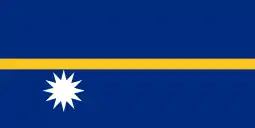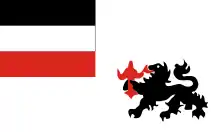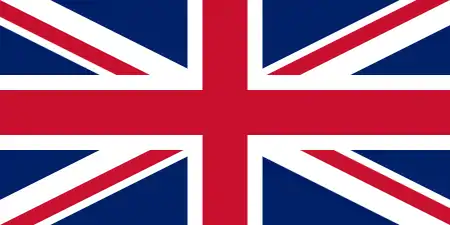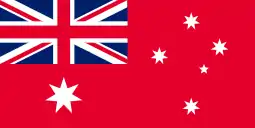Flag of Nauru
Following the independence of Nauru, the flag of Nauru (Nauruan: anidenin Naoero) was raised for the first time. The flag, chosen in a local design competition, was adopted on independence day, 31 January 1968. The design symbolically depicts Nauru's geographical position, with a star just south of the Equator.
 | |
| Use | State flag and civil ensign |
|---|---|
| Proportion | 1:2 |
| Adopted | 31 January 1968 |
| Design | A blue field with the thin yellow narrow horizontal stripe across in the center and the large white twelve-pointed star on the bottom of the stripe and near the hoist-side. |

Proportions and symbolism
The flag reflects the geographical location of the island nation.
The narrow gold stripe with a width of 1⁄12 of the length of the flag represents the Equator.[1][2] The stripe along with the star signifies the location of the island in the Pacific Ocean one degree south of the Equator.[3] The separation of the blue flag cloth into two equal parts recalls the saga, that the first inhabitants were to have been brought to Earth from two boulders.
Nauru itself is symbolised by a white 12-pointed star. The twelve points on the star represent the island's twelve original tribes.[1] The following twelve tribes are:[4]
- Deiboe
- Eamwidara
- Eamwit
- Eamwitmwit
- Eano
- Eaoru
- Emangum
- Emea
- Irutsi
- Iruwa
- Iwi
- Ranibok
The blue signifies the Pacific Ocean,[1] while the white colour of the star represents phosphate,[3] a former major natural resource of the country.
Construction Sheet
.svg.png.webp) flag construction sheet
flag construction sheet
Creation and adoption
The flag was created by a resident employed by the Australian flag manufacturer Evans. It was officially adopted on 31 January 1968. Unlike some flags of Pacific nations (e.g., that of Tuvalu), Nauru's flag has evoked little controversy.
Historical flags of Nauru
| Flag | Date | Use | Description |
|---|---|---|---|
 | 1888–1914 | When Germany took control of the island in 1888, it was administered under German New Guinea, with the flag of the German New Guinea Company being flown in the island.[3] | See: German New Guinea |
 | 1919–1948 | When Nauru was still under the trustee mandate of Australia and the United Kingdom, the Union Jack was flown in the island.[3] | See: Union Jack |
.svg.png.webp) | 1942–1945 | Flag of Nauru under the occupation of the Empire of Japan during World War II.[3] | See: Flag of Japan |
 | 1948–1968 | Flag of Nauru used during Trusteeship with Australia and the United Kingdom.[3] | See: Australian Red Ensign |
 | 1968– | Current flag of Nauru adopted on 31 January 1968 following its independence from the trusteeship.[3] |
See also
- Coat of arms of Nauru
- Nauru graph, named after its resemblance to the 12-pointed star on the flag
- Flag of Curaçao
References
- "The Nauruan Flag". Government of the Republic of Nauru. Retrieved 11 January 2018.
- "Nauru". Flag of the World. Retrieved 25 May 2021.
- "Flag of Nauru - A Brief History" (PDF). Flagmakers. Retrieved 11 January 2018.
- "Tribes of Nauru". Government of the Republic of Nauru. Retrieved 8 April 2021.